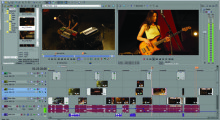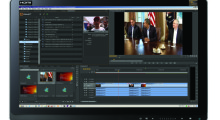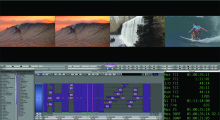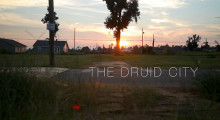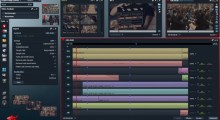FCP
-
Sony Vegas

I’ve been editing commercials and longform programs with Sony Vegas Pro since 2005. Our latest feature documentary, They Wore the Red Suit, was edited, color corrected and mixed totally in Vegas. Why Vegas? The editor I brought in for this project was experienced with Avid and FCP but had never used Vegas before. I asked him to try it for a few days, and if he wasn’t happy, I’d bring in the system of his choice. After a week, he said he couldn’t have made as much progress with either of his old “favorites.” My initial decision to use Vegas […]
by Larry W. Peter on Oct 22, 2013 -
Adobe Premiere Pro CC

The first project I used Adobe Premiere Pro on was a short film called “Masterpiece” that I created for Filmmaker Magazine at Sundance 2011. Prior to that, I’d been a Final Cut Pro devotee for a decade — and even reviewed the two previous generations of Final Cut Studio for Filmmaker. My history with digital editing goes back to late 2001. I was working on a short film, shot on 16mm, which I’d initially intended to cut on an old school Steenbeck. But when that fell through, I tracked down and installed a bootleg copy of Final Cut 2 on […]
by Jamie Stuart on Oct 21, 2013 -
Avid Media Composer

For many film editors, including yours truly, Avid’s Media Composer is the preferred software for cutting our work. It’s rock solid, powerful and once you really know how to use it, one of the most versatile tools for getting the job done. However, over the past several years the future of the Media Composer platform has been in doubt. Strong competitors moved into the marketplace, and Avid, once king of digital editing, seemed headed to the sidelines. But as fast as it seemed to fall, Media Composer may be making a comeback, due in part to major enhancements to the […]
by Todd Holmes on Oct 21, 2013 -
The Druid City: Interview with Kristyn Ulanday and Max Esposito

Kristyn Ulanday and Max Esposito graduated from the journalism department of Boston University in 2010. They both work commercially as freelance photographers and filmmakers, but in 2011 they also began a collaborative project called Full Frame America to tell the stories they wanted to tell. The first result of that collaboration is a 24-minute documentary, The Druid City, that focuses on the town of Tuscaloosa, Alabama and how the residents have coped after the town was hit by an EF4 tornado in April 2011. Filmmaker: How did you come to make this movie? Esposito: We both felt like we […]
by Michael Murie on Apr 29, 2013 -
The New Digital Storytelling Series: Ingrid Kopp

In the seventh part of Filmmaker‘s interview project with prominent figures from the world of transmedia, conducted through the MIT Open Documentary Lab, Ingrid Kopp, Director of Digital Initiatives at Tribeca Film Institute, answers our questions. Kopp oversees the TFI New Media Fund, runs Tribeca Hacks and produces TFI Interactive during the Tribeca Film Festival. For an introduction to this entire series, and links to all the installments so far, check out “Should Filmmakers Learn to Code,” by MIT Open Documentary Lab’s Sarah Wolozin. MIT Open Documentary Lab: How do you see people making the transition to digital interactive storytelling? Kopp: I think people have […]
by MIT Open Documentary Lab on Apr 18, 2013 -
Color Grading A Glimpse Inside the Mind of Charles Swan III, Part 1: Ryan Bozajian on the Art of the Pre-Grade

Like most motion pictures, Roman Coppola’s latest film, A Glimpse Inside the Mind of Charles Swan III was color graded in a DI theater at a post house. Unlike many films, this final grading only took two days; extensive “pre-grading” was done using Resolve Lite at American Zoetrope’s own facilities, while the final grade was performed at SPY using the full version of Resolve. With color grading taking place in two facilities and by two people, the facilities had to work together to calibrate equipment and create a consistent workflow. In part 1 of this series, VFX artist Ryan Bozajian […]
by Michael Murie on Mar 26, 2013 -
Sony Responds to RED, Blackmagic Fix and Avid Continues to Decline

Two weeks ago RED announced that they were suing Sony for patent infringement for technology used in Sony’s PMW-F5, PMW-F55, and F65 cameras. Last week Sony posted a response on their Pro video website. First noting that the F65 has been commercially available for over a year, and that the F5/F55 were announced in October, they go on to say: Sony has now had an opportunity to study Red’s complaint and the asserted patents, and categorically denies Red’s allegations. Sony intends to defend itself vigorously in the Red lawsuit. Sony looks forward to prevailing in court, thus vindicating the Sony […]
by Michael Murie on Mar 4, 2013 -
7 Recommended No-Budget Post-Production Tools

Being an independent filmmaker means we are often times working with very little money but still making our projects happen. We use any tools and tricks we can get our hands on to help us finish or enhance our films. Of course these have to fit within our budgetary constraints. Here is a list of post production tools that are affordable for the no budget filmmaker. 1. Blender – 3D Modeling & Animation (Win, Linux & Mac) I’m constantly amazed at what this FREE program can do. It includes many features found in competing 3D apps that cost hundreds and many […]
by Craig Bergonzoni on Jan 17, 2013 -
FCP X and the Future of Editing

Editing is older than motion pictures. The ordering and pacing of dialogues, scenes, entrances and exits to build conflict and resolution have long defined Western theater, from Aeschylus’s Oresteia to Wagner’s The Ring of the Nibelung [Der Ring Des Nibelungen]. It was the insertion of first-person thoughts into dialogue and plot that modernized 18th- and 19th-century novels and clever sequencing of mechanically animated magic lantern glass slides that thrilled Victorian audiences to popular epics like Ben-Hur.
by David Leitner on Nov 19, 2012
